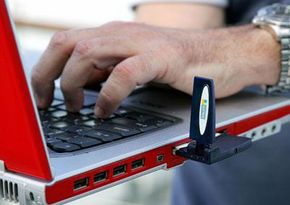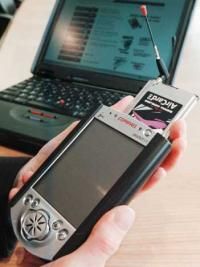Walk into any coffee shop and you'll see scores of people pecking away at their laptop computers. If you feel like everywhere you go -- from college campuses and libraries to Starbucks and McDonald's -- has wireless connectivity, you're not alone. Currently, 241,506 WiFi hot spots are scattered throughout 134 countries, and some of those "spots" are entire cities [source: JiWire].
These hot spots usually connect to the larger Internet community by wires or cables and broadcast the Internet signal wirelessly to individual computers using radio frequencies. Many personal computers pick up that signal using a wireless Internet card, a small device about the size of a credit card.
Advertisement
Wi-Fi everywhere. See more laptop pictures.
Wireless Internet cards, also known as Local Area Network, or LAN, cards, are one of the many types of adapter cards that add capabilities to your computer. Other adapter cards can enable teleconferencing, improve sound systems or download photos from a digital camera.
Wireless Internet cards come in several forms. Different cards exist for laptops, desktops and PDAs. Many computers come with one preinstalled, but they can also be purchased relatively inexpensively and self-installed or simply inserted into a slot on the side of the computer.
The sheer number of WiFi hot spots has made wireless Internet cards even more desirable. Initially used mostly in homes or businesses so that multiple people could share an Internet connection, they are a hot commodity for anyone with a computer, especially with entire cities going wireless. For more information, read How Municipal WiFi Works.
In this article, you'll learn how wireless Internet cards communicate with hot spots to connect to the Internet. You'll also learn about the different wireless cards available and what you should look for when buying one, so that you too can check your e-mail while sipping a soy latte.
Find out how a device no bigger than your hand can detect a signal hundreds of feet away on the next page.
Advertisement




